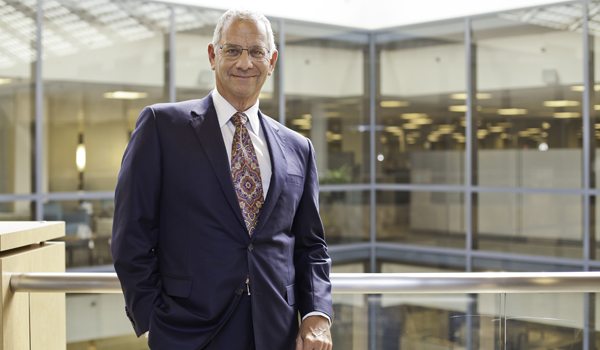Around the first of the year, Phoenix-based Banner Health is expected to close on a nearly $1 billion deal to acquire the University of Arizona Health Network and its subsidiaries. The deal will make Banner the largest private employer in the state, will pump least $500 million of spending on capital projects into the state’s economy of the the next five years and will pay of UAHN’s long-term debt, which totals about $146 million. Az Business sat down with Peter Fine, Banner’s president and CEO, to talk about the impact of the acquisition and the state of the healthcare industry.
Az Business: How have you been able to grow Banner through all the uncertainty in the healthcare industry?
Peter Fine: We have a lot of smart people at Banner. There is good leadership. There is good strategic thinking. There is great accountability. There is great discipline. There is great focus. It’s an organization that plans the work and works the plan.
AB: Hw have you been able to instill the discipline needed for growth?
PF: It’s a leadership culture. It’s an organization that strives to achieve, decides what it needs to get it done, throws a lot of resources at it to get t done and has leaders who feel accomplished when they achieve.
AB: Banner bought Casa Grande Medical Center last year when it was facing major financial issues. How were you able to turn it around so quickly?
PF: In this day and age of healthcare, there are a lot of pressures on healthcare organizations. Pressures are caused by a highly complicated environment, things are very ambiguous and it’s not always clear what to do. When you’re trying to respond to that kind of environment, which is an industry that’s trying to re-invent itself, that puts enormous pressure on individual organizations to maintain financial stability, high clinical quality and have the resources needed to invest in those things needed to re-invent yourself. Banner is able to spread fixed overhead over a big base. In a situation where an industry is re-inventing itself, you have to make investments — financial investments, people investments, resources , capital investments — and that becomes hard to do when it’s an industry that’s having its reimbursement environment restricted. So it becomes even more important to find ways to spread that fixed overhead investment over a big base to bring down your costs for services. Casa Grande recognized the reality of today’s world and its position in today’s world and believed that working with Banner would provide advantages for the community by creating a more stable environment.
AB: How does that business relationship impact patient care?
PF: We have a care model that we like to put in place. We have an electronic environment that has has been very beneficial in improving outcomes. Our ability to provide capabilities that some of the more rural hospitals could never have one their own leads to an enhanced clinical environment.
AB: How is consolidation helping the healthcare industry?
PF: Consolidation is doing multiple things. 1) It’s letting organizations grow and spread fixed overhead over a big base. 2) It’s allowing organizations to make investments that they might not otherwise be able to make because it can bring financial stability. 3) It allows us to get into new ways of providing business, so the Banner Health Network was created to allow us to get into value-based care and population health management. If we didn’t have all the infrastructure of Banner Health, it would be impossible to provide that capability. It offers new options to the public. It offers new options to businesses, where they can contract for services and bring down their cost-per-unit of service because it’s based on our ability to manage care. At the end of the day, it’s going to be very, very hard to get a whole lot more improvement on the acquisition of product to bring down your costs. There’s only so far you can go on managing labor and still provide a reasonable product. The next great effort to reduce the cost of healthcare is to manage care better, which means you have to have techniques and capabilities in place to look at the cost of care and decide what is really necessary in the provision of care and where can you reduce the use of services, especially for chronic care patients. If you coordinate care better, you’re going to use services better, as opposed to an environment where there is no coordination, duplication of services, duplication of testing and there is more cost associated with that. So this whole issue of providing people with the right care at the right time at the right place is really what the coordination of care is all about, what value-based care is all about and what risk assumption of care is all about. From our perspective, if you can organize yourself structurally to do that, you then have an opportunity to be far more competitive, especially with organizations that are putting more and more of the costs onto the consumer through co-payments, deductibles and reductions of coverage. Therefore, we are moving into consumer world where people are going to make decisions on how they purchase healthcare far differently than they’ve made those decisions before. It’s going to be based on where they can get the best value for the dollar that they’re spending.
AB: What do you expect from Round 2 of healthcare exchange enrollment?
PF: Some of the insurers provided an unsustainable price for the product they were trying to provide, so I think some of those prices are going to go up. I think there will be continued growth in the exchanges, partly because I think employers are going to start making different decisions on their coverage within their employee population.
AB: What’s been the impact of the Medicaid expansion?
PF: I can tell you I think it’s been a boon for the state. We’ve seen a significant impact. It’s had its desired effect. We’ve had a decrease of uninsured an increase of Medicaid-insured population as well as people on exchanges. But remember, a population like Medicaid pays of 63 cents or 65 cents on the dollar of full cost. That means we are still cross-subsidizing off of some other category. But it is taking that category where there was no reimbursement at all and and making that category smaller. The best thing is that the part paid for by the federal government is only going to go up. 17 percent down to 10 percent.
AB: How do you hope the acquisition of the University of Arizona Health Health Network will impact the business side Banner Health?
PF: It’s a big acquisition and a complicated acquisition. Part of the goal is to help stabilize an academic environment which is beneficial to the state, but another part of the goal is growing Banner’s presence in other markets and build our state-wide presence for various contracting opportunities later on. It has the potential to be highly beneficial and we will be the primary teaching relationship for the two medical schools. We think we can help stabilize some of the issue around academic medicine and the clinical environment surrounding academic medicine. For us, it links us to a research and academic environment that we think will enhance the work that we do.
AB: How do you hope the purchase of the University of Arizona Health Health Network will impact the cutting-edge research already being done at Banner Health?
PF: It’s going to grow the research base of Banner. Today, Alzheimer’s is the biggest focus for us from a research perspective. As we move into a more direct environment with the medical schools, we are going to find other opportunities to invest significantly into this world of research as it pertains to the clinical environment. You’re going to see us make more investment in the clinical research side. I know there are folks at UA who love the idea of having access to the totality of Banner’s database, which can advance the research cause of the medical school.
AB: How does research fit into your mission and goals for Banner Health?
PF: Research has not been a priority in the past. It has been driven mostly by specific physician interest. When we acquired the Sun Health system in 2008, we acquired the Sun Health Research Institute, so that pushed some of our thinking. Clearly, our Alzheimer’s Institute has been a major area of focus. With this new relationship, I think you’re going to see a growing effort to be more involved in research, but specifically clinical research to improve patient outcomes and devise strategies to improve population health management.
AB: Which of Banner Health’s accomplishments give you the most pride?
PF: I came to Banner 14 months after the creation of the organization. (Editor’s note: Banner Health was created on Sept. 1, 1999, when nonprofits Samaritan Health System and Lutheran Health Systems announced their merger). Part of the job when was came was respecting history, but not being controlled by it. The goal was to take the historical essence and cultures of two organizations and create a new one. That can be very risky because people are very proud of their historical base. I’m not a retrospective thinker, I’m a prospective thinker. But if I had to say what I’m most proud of, it’s that we’ve been able to get Banner to look to the future, to not hold onto its historical past, recognize that this is an industry in turmoil that’s being re-invented and get people to focus on where we are going.
AB: How did you make that happen?
PF: Thirteen years ago, we created “Banner’s 2020 Vision,” which has been Banner’s guide since that period of time. It’s a 20-year-game plan to re-invent the organization. Some would say, “That’s really bold. You’re going to produce a 20-year game plan to direct your organization for that long a period of time?” We did and it has been a guiding reference tool for us for all the things we do — for strategies that we have, for tactics that we implement, the way we focus people, the way we pay people. It has been an overriding influence on the company’s direction and approach for dealing with an industry in turmoil. Without this guide, Banner could have been an organization that fell off the cliff. Instead of that happening, we’ve been able to bring together two cultures and get them to ficus on the future and it’s been one of Banner’s hallmark successes.




